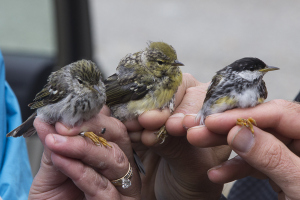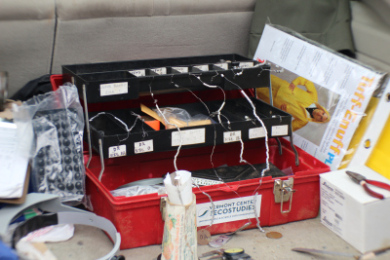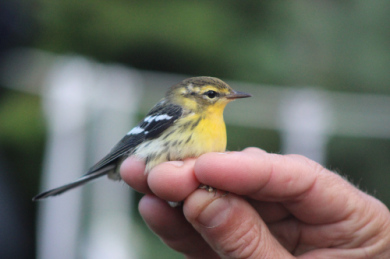
A Blackpoll Warbler trio from the mist nets. From left to right: adult female, juvenile, adult male (photo courtesy of Roy Zartarian)
Always a bittersweet summer milestone, VCE’s wrap-up visit to the Mt. Mansfield ridgeline in late July featured a quiet avian chorus but an abundance of juvenile birds in our mist nets.
We timed our July 23 arrival well, ascending the toll road just minutes after torrential, late-afternoon rains had swept across the mountain and moved east. Clouds clung to the ridgeline, but temperatures were warm and winds light. We donned rubber boots and rain gear before opening our 25 nets, navigating puddles and slippery rocks along the trails. The ridgeline was eerily quiet, with only sporadic White-throated Sparrow songs. Few birds were moving through the rain-soaked vegetation, and we captured only five individuals before dark, two of them juvenile Bicknell’s Thrushes (BITH). The dusk “chorus” was a shred of its former self, as we heard only a few muted BITH calls and a handful of subdued songs.
Closing nets at dusk and descending to our home away from home – the ski patrol hut at 3500’ elevation – we took full advantage of shortening daylength and gratefully slept in until 4 am. All nets were open by 4:30, with dawn still unfolding. Clouds began to lift off the ridgeline, and we were treated to a tranquil morning, one of many that characterized our June and July field season. Few birds of any species vocalized, the notable exception being two male American Robins, which sang heartily throughout the morning. Avian activity slowly gained momentum, and by noon we had captured 36 individuals – 41 for the visit, of which more than half (21) were juveniles. Typical for late July, several captures were of non-local birds presumably dispersing from either their natal or breeding home ranges.
Many adults were in early-mid stages of post-breeding molt, when reduced flight capabilities lead to more skulking behavior (and fewer mist net captures). Juveniles displayed various stages of “punk” attire, via their molt of body feathers from juvenal to first prebasic (winter) plumage. One Blackpoll Warbler family netted simultaneously featured a dazzling array of mid-summer fashion statements.
Unexpected among juvenile captures were a Downy Woodpecker, a Brown Creeper, and a Blackburnian Warbler (only our second ever in summer). A yearling male Hermit Thrush and three young-of-the-year Black-throated Blue Warblers rounded out the non-local wanderers. For the first time since our initial 2014 visit on June 4, we did not capture an adult BITH, nor did we capture or even hear a Swainson’s Thrush (SWTH). Our seasonal total of 50 BITH captures (45 adults, 5 juveniles) exceeded the previous two years’ totals of 35 (34 adults, 1 juvenile) in 2012 and 40 (all adults) in 2013. Our final tally of 20 SWTH captures (19 adults, 1 juvenile) easily eclipsed any previous year’s total, e.g., 12 birds in 2012 and 7 in 2013.
While we didn’t succeed in our quest to recover a fourth Blackpoll Warbler geolocator, the 2014 field season was an unqualified success, with more than 300 captures overall. We’ll tally results in the weeks ahead, compare them to those from our previous 22 years, and examine what may lie behind any trends that emerge. We hope to return to the Mansfield ridgeline in mid-September for our near-annual “mop-up” visit, hoping for that elusive fourth geolocator and a final hands-on encounter with any birds that haven’t yet departed for points south.


